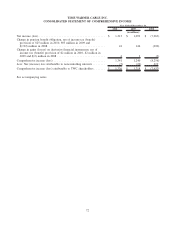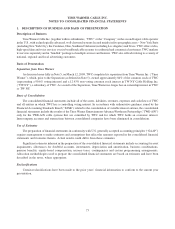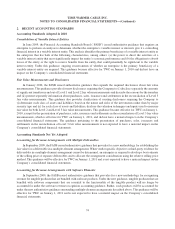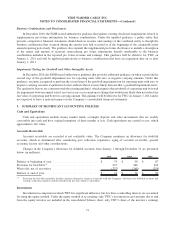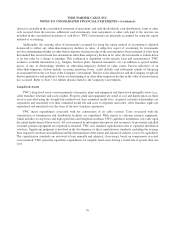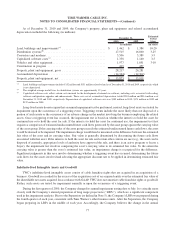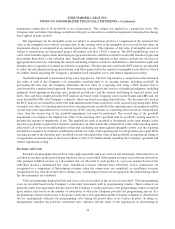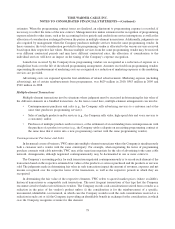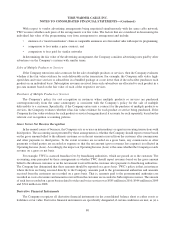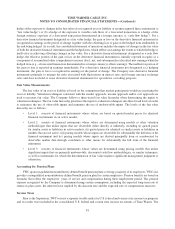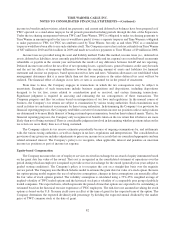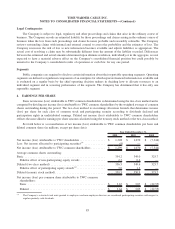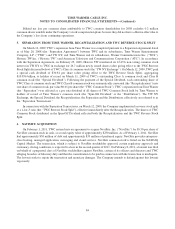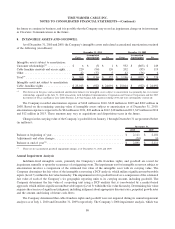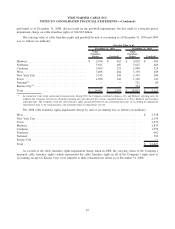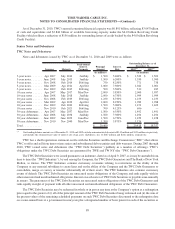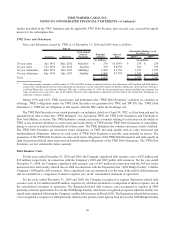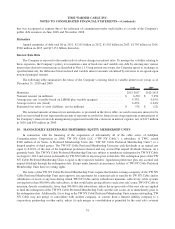Time Warner Cable 2010 Annual Report Download - page 94
Download and view the complete annual report
Please find page 94 of the 2010 Time Warner Cable annual report below. You can navigate through the pages in the report by either clicking on the pages listed below, or by using the keyword search tool below to find specific information within the annual report.income tax benefits and provisions, related tax payments, and current and deferred tax balances have been prepared as if
TWC operated as a stand-alone taxpayer for all periods presented including periods through the date of the Separation.
Under the tax sharing arrangement between TWC and Time Warner, TWC is obligated to make tax sharing payments to
Time Warner in amounts equal to the taxes it would have paid if it were a separate taxpayer and Time Warner is obligated
to make payments to TWC for TWC tax attributes used by Time Warner, but only as and when TWC as a standalone
taxpayer would have been able to use such attributes itself. The Company received net cash tax refunds from Time Warner
of $87 million in 2010 and $44 million in 2009 and made net cash tax payments to Time Warner of $9 million in 2008.
Income taxes are provided using the asset and liability method. Under this method, income taxes (i.e., deferred tax
assets, deferred tax liabilities, taxes currently payable/refunds receivable and tax expense) are recorded based on amounts
refundable or payable in the current year and include the results of any difference between GAAP and tax reporting.
Deferred income taxes reflect the tax effect of net operating losses, capital losses, general business credit carryforwards
and the net tax effects of temporary differences between the carrying amount of assets and liabilities for financial
statement and income tax purposes, based upon enacted tax laws and rates. Valuation allowances are established when
management determines that it is more likely than not that some portion or the entire deferred tax asset will not be
realized. The financial effect of changes in tax laws or rates is accounted for in the period of enactment.
From time to time, the Company engages in transactions in which the tax consequences may be subject to
uncertainty. Examples of such transactions include business acquisitions and dispositions, including dispositions
designed to be tax free, issues related to consideration paid or received, and certain financing transactions.
Significant judgment is required in assessing and estimating the tax consequences of these transactions. The
Company prepares and files tax returns based on interpretation of tax laws and regulations. In the normal course of
business, the Company’s tax returns are subject to examination by various taxing authorities. Such examinations may
result in future tax and interest assessments by these taxing authorities. In determining the Company’s tax provision for
financial reporting purposes, the Company establishes a reserve for uncertain income tax positions unless such positions
are determined to be more likely than not of being sustained upon examination, based on their technical merits. That is, for
financial reporting purposes, the Company only recognizes tax benefits taken on the tax return that it believes are more
likely than not of being sustained. There is considerable judgment involved in determining whether positions taken on the
tax return are more likely than not of being sustained.
The Company adjusts its tax reserve estimates periodically because of ongoing examinations by, and settlements
with, the various taxing authorities, as well as changes in tax laws, regulations and interpretations. The consolidated tax
provision of any given year includes adjustments to prior year income tax accruals that are considered appropriate and any
related estimated interest. The Company’s policy is to recognize, when applicable, interest and penalties on uncertain
income tax positions as part of income tax expense.
Equity-based Compensation
The Company measures the cost of employee services received in exchange for an award of equity instruments based
on the grant date fair value of the award. That cost is recognized in the consolidated statement of operations over the
period during which an employee is required to provide service in exchange for the award (generally four years subject to
graded vesting conditions). The Company’s policy is to recognize the cost on a straight-line basis over the requisite
service period. The Company uses the Black-Scholes model to estimate the grant date fair value of a stock option. Because
the option-pricing model requires the use of subjective assumptions, changes in these assumptions can materially affect
the fair value of stock options granted. The volatility assumption is calculated using a 75%-25% weighted average of
implied volatility of TWC traded options and the historical stock price volatility of a comparable peer group of publicly
traded companies. The expected term, which represents the period of time that options are expected to be outstanding, is
estimated based on the historical exercise experience of TWC employees. The risk-free rate assumed in valuing the stock
options is based on the U.S. Treasury yield curve in effect at the time of grant for the expected term of the option. The
Company determines the expected dividend yield percentage by dividing the expected annual dividend by the market
price of TWC common stock at the date of grant.
82
TIME WARNER CABLE INC.
NOTES TO CONSOLIDATED FINANCIAL STATEMENTS—(Continued)


